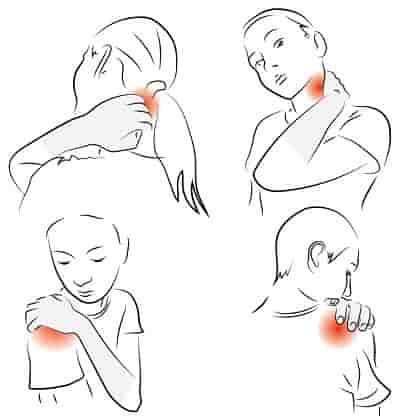Neck and Arm Pain

What is Cervical Radiculopathy?
Cervical Radiculopathy is a condition where a nerve in the cervical spine is compressed (pinched) by a slipped disc or bone. It often gets manifested as pain which travels from the neck into the shoulder and to specific regions of the upper arm, forearm, hand, or fingers. In numerous cases, numbness or weakness in certain muscles might accompany the pain.
What are the causes of Cervical Radiculopathy?
- Infection of the nerves (nerves under pressure).
- Inflamed or damaged nerve root.
- Serious back or nerve issues.
- Muscle strain.
- Sudden neck movement or awkward neck positioning while sleeping.
- Slipped disc.
- Pinched nerve.
- Disks wearing out.
- Cervical spinal stenosis.
- Whiplash injury.
- Bad posture while sitting at a desk for long periods.
- Aging.
What are the symptoms of Cervical Radiculopathy?
- A short sharp pain that feels like an electric shock, occurs while doing a specific task.
- Restriction of a range of neck and arm movements.
- An intense pain in the neck and arm resulting from injury.
- Pain accompanied by swelling or a change in the shape of your arm.
- Pain that worsens when you use your arm.
- Pins and needles, tingling or numbness in the arms, hands or fingers.
Most symptoms can be relieved by carrying out general daily activities and maintaining good posture.
How is Cervical Radiculopathy diagnosed?
After an initial clinical examination of the area concerned, a number of evaluation methods may be needed depending on how severe the pain is and how long you had the pain for. We need to establish the following:
- If the pain is linked to the neck, arm or other parts of the body.
- How persistent the pain is.
- The symptoms associated with the pain.
- The exact location of the pain the patient is having, the patient’s job, their regular activities.
- Any previous injuries and associated treatments.
Evaluation methods such as X-Rays, CT scans and MRIs can be used to diagnose and evaluate the cause of the pain. Spurling test can also be used to diagnose cervical radiculopathy. The Spurling test result is considered positive if it generates pain (i.e. the patient may have cervical radiculopathy), otherwise, the test result is negative (i.e. the patient does not have cervical radiculopathy).
What are the treatments for Cervical Radiculopathy?
Once diagnosis is made, treatments can be started (non-surgical and/or surgical).
Possible non-surgical treatments for Cervical Radiculopathy are:
- Physiotherapy with non-invasive exercises.
- General light daily exercises.
- Medications such as painkillers – these may not be as effective in the case of having severe pain due to nerve root compression.
When non-surgical treatments do not relieve the pain after 4-6 weeks, further examinations and assessment by a doctor is required where physical therapy will be next. Steroid injections may also be considered.
If still no improvement, then more investigations are needed, and surgical treatment will be indicated at that time.
The type of surgical procedures that may be required will depend on the type of pain, symptoms and the location of the affected nerve root.

